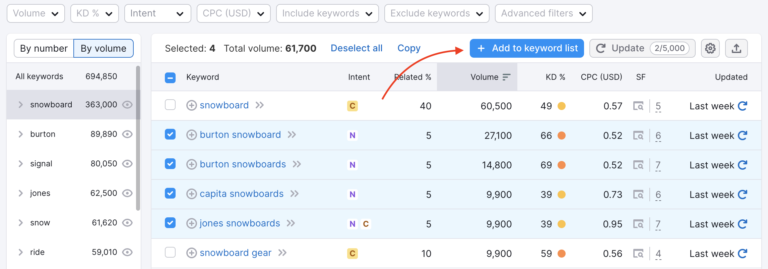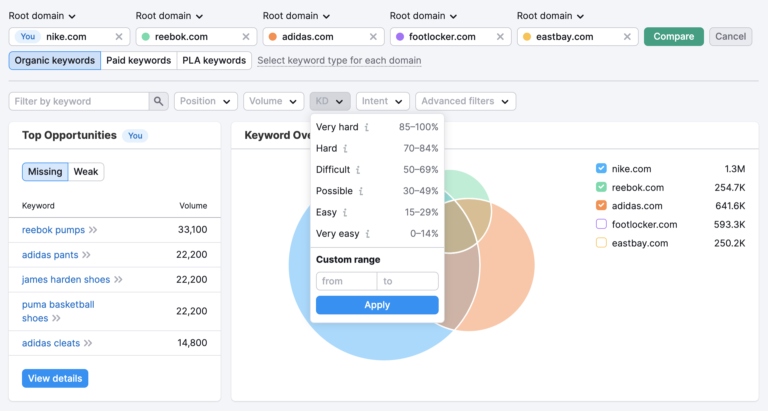Keyword research is vital for online success. It helps you find the right words to attract visitors to your site.
Knowing how to use tools like Semrush can simplify this process. Semrush is a powerful tool for anyone looking to enhance their SEO strategy. It provides valuable insights into what keywords your audience searches for. With Semrush, you can analyze competitors, discover trending topics, and find high-traffic keywords.
This tool makes keyword research easy, even for beginners. Understanding how to use Semrush effectively can lead to more website traffic and better content. In this guide, we will explore step-by-step how to leverage Semrush for your keyword research needs. Get ready to improve your online presence with the right keywords.
Introduction To Semrush And Keyword Research
Keyword research is a key part of SEO. It helps you find the right words and phrases. These words attract visitors to your website. Semrush is a powerful tool for this task. It makes keyword research easier and more effective.
The Role Of Keywords In Seo
Keywords are essential for search engines. They connect users to content. Here are a few important points:
- Keywords help search engines understand your content.
- Using the right keywords can improve your ranking.
- Keywords attract targeted traffic to your site.
Focus on relevant keywords. Think about what your audience searches for. Use a mix of short-tail and long-tail keywords. Short-tail keywords are broad. Long-tail keywords are more specific and targeted. Both are important for a balanced strategy.
Semrush: A Brief Primer
Semrush is an all-in-one SEO tool. It provides insights into keyword performance. You can analyze competitors and find new opportunities.
Here’s what Semrush offers:
| Feature | Description |
|---|---|
| Keyword Overview | See search volume, trends, and difficulty. |
| Keyword Magic Tool | Discover related keywords and phrases. |
| Position Tracking | Track your keyword rankings over time. |
| Competitor Analysis | Analyze competitors’ keyword strategies. |
Use Semrush to get detailed reports. These reports guide your keyword strategy. Start with the Keyword Overview tool. It shows you vital information about any keyword.
Semrush simplifies the research process. It helps you find keywords that fit your content goals.
Setting Up Your Semrush Account
Starting with Semrush is easy. You just need to set up your account. This first step is important for your keyword research. Let’s look at how to do it.
Creating An Account
To create an account, go to the Semrush website. Click on the “Sign Up” button. You can register using your email or social media accounts. Fill in the required details. Make sure to use a strong password.
After registration, check your email for a confirmation link. Click the link to verify your account. Once verified, you can log in to Semrush. This is your entry point to keyword research.
Navigating The Dashboard
After logging in, you will see the Semrush dashboard. The dashboard is user-friendly. It shows different tools for SEO and marketing.
Look for the “Keyword Research” section. This area will help you find relevant keywords. You can also view search volumes and trends. Explore other tabs for more features. Familiarizing yourself with the dashboard is crucial.
Take your time. Click on different options. This will help you understand the tools available. Knowing the dashboard will make your research easier.
Identifying Your Keyword Goals
Setting clear keyword goals is crucial for effective SEO. It guides your content strategy. Understanding what you want to achieve helps in choosing the right keywords. Use Semrush to identify these goals accurately.
Establishing Your Seo Objectives
Start by defining your main goals. What do you want to achieve with SEO? Here are some common objectives:
- Increase website traffic
- Boost brand awareness
- Generate leads
- Increase sales
Each goal requires different keyword strategies. For example, if you want to boost traffic, focus on high-volume keywords. For leads, use long-tail keywords.
Understanding Searcher Intent
Searcher intent is key to choosing effective keywords. It refers to why people search for something. Understanding this helps in creating relevant content. There are three main types of searcher intent:
| Type of Intent | Description |
|---|---|
| Informational | Users seek information or answers. |
| Navigational | Users want to find a specific website. |
| Transactional | Users aim to make a purchase. |
Identify the intent behind your target keywords. This allows you to align your content with user needs. Use Semrush to analyze keywords and their intent. Choose keywords that match your SEO objectives.
Starting Your Keyword Search
Keyword research is the first step to improving your SEO. Using Semrush can make this task easier. You can find the right keywords quickly. This helps you target the right audience. Start by entering a keyword or phrase related to your topic. Semrush will provide valuable data to guide your choices.
Using The Keyword Overview Tool
The Keyword Overview Tool is a great starting point. Enter your chosen keyword in the search bar. Click on the search icon to get instant results. This tool shows important data about the keyword. You will see the search volume, trends, and related keywords.
Use this information to understand how popular a keyword is. You can also explore different variations of the keyword. This helps you find the best options for your content.
Interpreting Search Volume And Difficulty
Search volume tells you how many people search for a keyword. A high search volume means more potential traffic. Check the number of searches per month. This gives you a clear picture of the keyword’s popularity.
Keyword difficulty shows how hard it is to rank for that keyword. A higher number means more competition. Balance your choice between search volume and difficulty. Aim for keywords that are popular but not too competitive. This strategy will improve your chances of ranking higher in search results.
Analyzing The Competition
Understanding your competition is vital for effective keyword research. It helps you see what works well in your niche. By analyzing competitors, you gain valuable insights. This leads to better strategies for your own content. Semrush provides tools to simplify this process.
Competitor Keyword Research
Start by identifying your main competitors. Use Semrush to find keywords they rank for. This can show you which keywords drive traffic to their sites. To perform competitor keyword research:
- Enter a competitor’s domain in Semrush.
- Navigate to the “Organic Research” section.
- Review the keywords they rank for and their positions.
This gives you a clear view of their keyword strategy. Focus on keywords with high volume and lower difficulty. These are opportunities for your own content.
Gleaning Insights From Competitor Data
Once you have competitor keywords, analyze the data. Look at their traffic trends and keyword positions. This will help you understand their strengths and weaknesses.
Consider the following aspects:
- Keyword Difficulty: Check how hard it is to rank for specific keywords.
- Traffic Volume: See how much traffic each keyword brings.
- Search Intent: Determine if the keywords match user needs.
Use this data to refine your own keyword list. Focus on keywords that have potential but are less competitive. This strategy can lead to better rankings.
| Competitor | Keyword | Traffic Volume | Keyword Difficulty |
|---|---|---|---|
| Competitor A | Keyword 1 | 1,200 | 35% |
| Competitor B | Keyword 2 | 900 | 40% |
| Competitor C | Keyword 3 | 1,500 | 30% |
This table shows competitor keyword data clearly. Use it to identify strong keywords for your strategy. Analyzing the competition helps you create focused content.

Credit: m.youtube.com
Expanding Your Keyword List
Expanding your keyword list is crucial for SEO success. A larger list gives you more options for content creation. It helps you find new topics and phrases to target. This process makes your website more visible.
Employing The Keyword Magic Tool
The Keyword Magic Tool in Semrush is a powerful resource. It offers a wide variety of keywords related to your main topic. Here’s how to use it:
- Log in to your Semrush account.
- Navigate to the “Keyword Magic Tool” section.
- Type in a seed keyword. This is your main keyword.
- Choose your target country for localized results.
- Click “Search.”
The tool will show a list of related keywords. You can filter these results by volume, difficulty, and trends. This helps you find keywords that fit your needs.
Finding Long-tail Keywords
Long-tail keywords are phrases with three or more words. They are specific and often have lower competition. These keywords can attract targeted traffic. Follow these steps to find long-tail keywords:
- Use the Keyword Magic Tool again.
- Look for keywords with lower search volume.
- Check the keyword difficulty score.
- Focus on phrases that match user intent.
For example, instead of “shoes,” try “best running shoes for flat feet.” This phrase targets a specific audience. Long-tail keywords can lead to higher conversion rates.
Here’s a quick overview of the benefits:
| Benefit | Description |
|---|---|
| Less Competition | Long-tail keywords usually face less competition. |
| Targeted Traffic | Attracts users looking for specific solutions. |
| Higher Conversion Rates | Users are often further along in their buying journey. |
Finding and expanding your keyword list is essential. Use these tools and tips to enhance your SEO strategy.
Refining Your Keyword Strategy
Refining your keyword strategy is crucial for effective SEO. It helps you target the right audience. Using Semrush can make this process easier. This tool offers many features to help you find and prioritize keywords.
Sorting And Filtering Options
Semrush provides useful sorting and filtering options. These features help you narrow down your keyword choices. Here’s how to use them:
- Sort by Volume: Focus on keywords with high search volume.
- Filter by Difficulty: Look for keywords that are easier to rank for.
- Use Location Filters: Target specific regions or countries.
- Search Intent: Choose keywords based on user intent, like informational or transactional.
These options allow you to create a more tailored list of keywords. You can adjust your strategy based on your niche.
Prioritizing Keywords For Campaigns
After filtering, it’s time to prioritize your keywords. Consider these factors:
- Relevance: Ensure the keyword matches your content.
- Search Volume: Choose keywords with higher search volumes.
- Keyword Difficulty: Aim for lower difficulty scores for quicker wins.
- Click-Through Rate (CTR): Focus on keywords with higher CTR potential.
Make a table to visualize your priorities:
| Keyword | Search Volume | Difficulty | Relevance |
|---|---|---|---|
| Example Keyword 1 | 1,500 | 35 | High |
| Example Keyword 2 | 750 | 20 | Medium |
| Example Keyword 3 | 300 | 10 | High |
This table helps you visualize your best keywords. Focus on keywords that offer a good balance of volume and difficulty.
Refining your keyword strategy with Semrush leads to better SEO results. Spend time on sorting and prioritizing. This will improve your chances of ranking higher.

Credit: www.semrush.com
Tracking Your Keyword Performance
Tracking your keyword performance is crucial. It helps you see how well your keywords are doing. You can adjust your strategy based on real data. This will improve your SEO results over time.
With Semrush, you can easily track your keywords. This tool provides valuable insights. You can measure your progress and identify areas for improvement.
Setting Up Position Tracking
Start by setting up position tracking in Semrush. Go to the dashboard and find the Position Tracking tool. Enter your domain name and add the keywords you want to track.
You can choose the location and device type. This helps tailor the results to your audience. Save your settings to begin tracking.
Semrush will provide daily updates on your rankings. You can see where you stand for each keyword. This information is key for your SEO strategy.
Analyzing Performance Metrics
After setting up tracking, analyze your performance metrics. Look at your keyword rankings regularly. Note any changes in position over time.
Pay attention to the visibility score. This shows how visible your website is in search results. A higher score means better performance.
Check the traffic metrics as well. This shows how much traffic each keyword brings. Use this data to refine your keyword strategy.
Identify keywords that are improving or declining. Focus on those that need attention. Use these insights to optimize your content and boost rankings.
Integrating Keywords Into Content
Using Semrush for keyword research helps you find the right terms. Integrating these keywords into your content boosts visibility. It makes your writing more relevant to search engines. This section covers best practices for content creation. It also looks at how to monitor your content’s effectiveness.
Content Creation Best Practices
Start with a clear focus. Choose a primary keyword for your piece. Use this keyword in the title. Place it in the first paragraph too.
Use related keywords throughout your text. This helps search engines understand your content better. Include keywords naturally. Avoid keyword stuffing. It makes your writing hard to read.
Break up text with headings. Use H2 and H3 tags for organization. This improves readability. It also helps search engines scan your content easily.
Write engaging meta descriptions. Include your primary keyword. This encourages clicks from search results. Keep meta descriptions under 160 characters.
Monitoring Content Effectiveness
After publishing, track your content’s performance. Use Semrush to monitor keyword rankings. This shows how well your keywords are doing.
Check user engagement metrics. Look at time spent on page and bounce rates. High engagement means your content is useful.
Update underperforming content. Add new keywords or improve existing ones. This keeps your content fresh and relevant.
Regularly review your keyword strategy. Adjust based on performance data. Stay flexible to improve your content’s reach.
Advanced Tips And Tricks
Using Semrush for keyword research can be simple. But there are advanced tips that can enhance your experience. These tips help you find the best keywords efficiently. Let’s explore these techniques.
Utilizing Semrush Api
The Semrush API allows you to access data programmatically. This can save time and effort. Here are some key benefits:
- Automate keyword research tasks.
- Gather large amounts of data quickly.
- Integrate with other tools and platforms.
To use the API, follow these steps:
- Sign up for a Semrush account.
- Access your API key from the dashboard.
- Use the API to pull data on keywords, domains, and more.
Here is a simple code example to get started:
const axios = require('axios');
const apiKey = 'YOUR_API_KEY';
const keyword = 'YOUR_KEYWORD';
axios.get(`https://api.semrush.com/keywords/v1?key=${apiKey}&keyword=${keyword}`)
.then(response => {
console.log(response.data);
})
.catch(error => {
console.error(error);
});Exploring Multinational And Mobile Databases
Semrush provides data for different countries and devices. This is useful for global campaigns. Here’s how to explore these databases:
- Select your target country in the Semrush dashboard.
- Check mobile-specific keywords.
- Analyze trends in different regions.
Consider the following points:
| Database | Benefit |
|---|---|
| Multinational | Understand keyword performance across countries. |
| Mobile | Identify keywords popular on mobile devices. |
Using these databases helps tailor your strategy. Focus on the keywords that matter to your audience.
Conclusion: Measuring Success With Semrush
Measuring success with Semrush is key for effective keyword research. Use the tools provided by Semrush to track your progress. This helps you understand what works and what needs improvement.
Reviewing Your Keyword Research Journey
Take time to review your keyword research. Look at what keywords brought traffic. Focus on these key points:
- Traffic numbers
- Conversion rates
- Search rankings
Create a table to summarize your findings. This allows for easy comparisons.
| Keyword | Search Volume | Traffic | Rank |
|---|---|---|---|
| Example Keyword 1 | 1,000 | 500 | 5 |
| Example Keyword 2 | 2,000 | 600 | 3 |
Analyze this data. Identify strong keywords. Recognize areas needing adjustment. This review enhances future keyword strategies.
Planning Future Strategies
Use the insights gained to plan for the future. Set clear goals for your next research phase. Consider these steps:
- Choose new keywords based on past performance.
- Expand into related topics or niches.
- Regularly update and refine your keyword list.
Regularly check your keyword performance. Adjust your strategies as needed. This keeps your content fresh and relevant.
Semrush simplifies measuring keyword success. Use its features to track, analyze, and improve your keyword strategies. Your content will benefit from this continuous improvement.

Credit: www.honeybook.com
Frequently Asked Questions
How Does Semrush Help In Keyword Research?
Semrush is a powerful tool for keyword research. It provides insights into keyword volume, competition, and trends. You can discover new keywords and analyze their potential. This helps in optimizing your content for better search visibility and attracting targeted traffic.
What Are The Key Features Of Semrush For Keywords?
Semrush offers several key features for keyword research. You can access keyword suggestions, search volume data, and difficulty scores. It also includes competitive analysis and organic traffic insights. These features help you make informed decisions for your SEO strategy effectively.
Can I Track Keyword Rankings With Semrush?
Yes, Semrush allows you to track keyword rankings easily. You can monitor your website’s performance for specific keywords over time. The tool provides detailed reports and insights on ranking changes. This is essential for adjusting your SEO tactics and improving visibility.
How Do I Find Long-tail Keywords Using Semrush?
To find long-tail keywords in Semrush, start with the Keyword Magic Tool. Enter a broad keyword to generate a list of related long-tail options. You can filter results by search volume and difficulty. This helps you identify low-competition keywords to target in your content.
Conclusion
Using Semrush for keyword research is straightforward and effective. This tool helps you find the right keywords for your content. Start by exploring the keyword magic tool. Analyze search volume and competition. Identify long-tail keywords for better results. Keep refining your strategy based on data insights.
Regularly check your rankings and adjust as needed. With practice, you will improve your keyword strategy. This can lead to more traffic and better content visibility. Start using Semrush today to enhance your keyword research skills. Happy researching!





